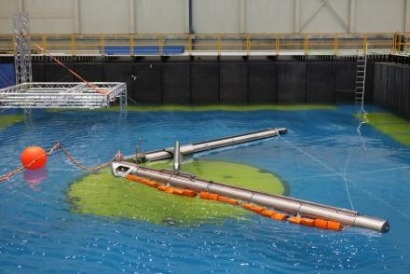
Wave energy devices come in many shapes from snakes to clams, but all have one thing in common. They are only just beginning to reach commercial viability. The Danish team behind Weptos hope their device represents “a superior technology for tapping into the vast energy resources of the world's oceans” and due to its reduced cost, will reach commercialisation sooner than many of its competitors.
According to the new online magazine, ScienceNordic.com, a prototype of the two-legged Weptos wave power plant was tested in a new wave tank in Santander (Spain) in September, with the unit performing “extraordinarily well”.
“I think this unit has a very good chance of making a breakthrough in this field,” says Jens Peter Kofoed, an associate professor at Aalborg University’s Department of Civil Engineering, where Weptos is being developed.
Kofoed is confident that Weptos overcomes some of the weaknesses of other wave energy converters. One of the problems inherent in any wave energy plant is that waves vary considerably in height. However, he Weptos device differs from other known projects in that it can extract energy from a much wider range of wave conditions.
Highly adaptable to wave conditions
The angle between the two legs can be adjusted; moving the legs further apart when the waves are small and suitable for generating electricity, or closer together in heavy sea conditions. This reduces the impact of storm waves on Weptos, thereby reducing the stresses and strains on the construction. It also means energy output can be kept constant despite varying wave conditions.
“Since you have the ability to change the angle between the legs, you are changing the amount of energy reaching the generator,” Kofoed told ScienceNordic.com. “But you are also ensuring that the stresses and strains on the construction in extreme situations are quite close to those in the normal, everyday situation.”
This also enables the Weptos plant to be deployed in “low energy” waters e.g. coastal environments where infrastructure connection, surveillance and maintenance costs are low. Consequently, the Weptos plant provides an economically sound solution for even areas with smaller waves.
After analysing the data from the testing in Spain, the Weptos team will work on calculating the optimal sizes of the unit and how much they will cost to build. Tommy Larsen, the entrepreneur behind the project, envisages the next version being some 10-15 times larger than the current prototype, but only medium-sized compared with the final version.
“We see the next step as being a demonstration installation in the Kattegat Sea [between Denmark and Sweden],” says Kofoed. “It is unlikely to be economically viable, but it will show that it can produce electricity, and we can get information that will verify our price calculations for an economically profitable unit to be located in say the North Sea.”
Kofoed is planning to test the next prototype in the Kattegat Sea within a couple of years, and if the device proves successful, a final version will be built over the following two years.
If all goes well, Weptos may then start a new Danish export boom, concludes Kofoed. “Internationally the market is large. A lot of money is being spent on developing wave power units and the expectations to what they can deliver are very high.”
[Editor’s note: Thanks to ScienceNordic.com for sending us information on this project.]
For additional information:

